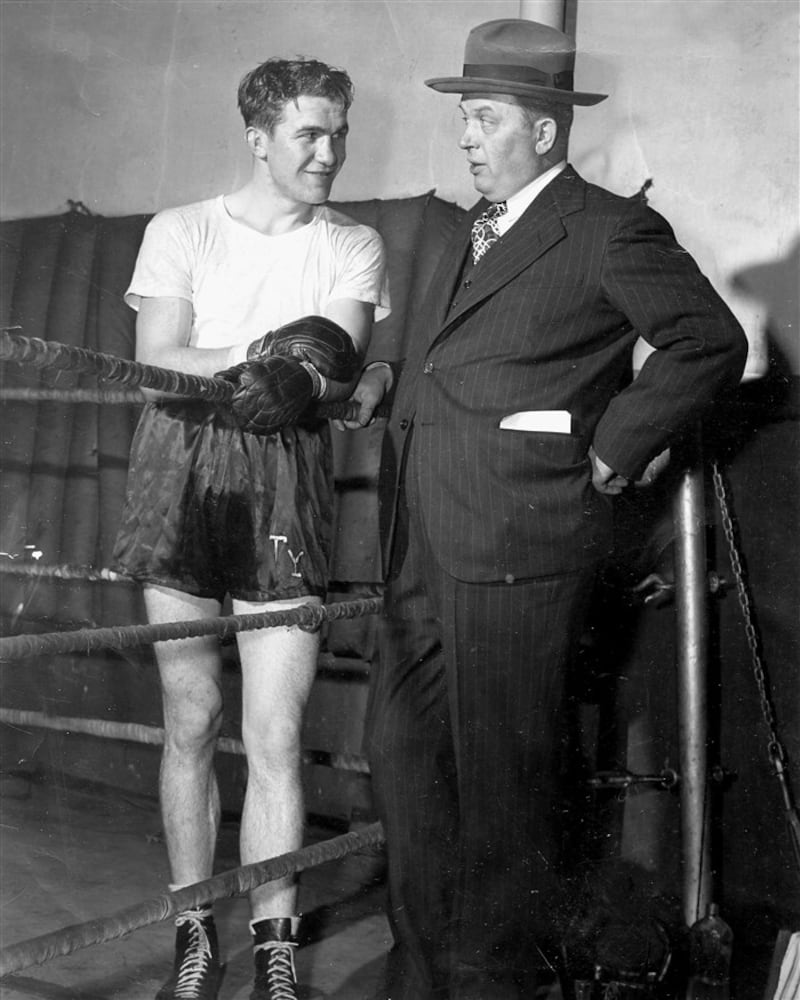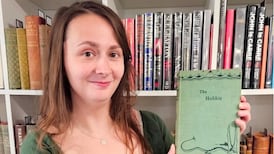On Saturday mornings, starting in 1946, I went with my dad to watch the boxers he managed get in shape for upcoming bouts. Women weren’t allowed in the gym of the Pittsburgh Lyceum, now the site of Chatham Towers, but none of the signs said anything about eight-year-old girls.
After Dad wrote our names in the notebook chained to a mahogany desk watched over by a gloomy man who never said hello, we’d head past the basketball court toward the hallowed sanctuary with the boxing ring, punching bags, and dirty mats.
The smells grew more pungent as we drew near. Scents of evergreen and arnica mingled with sweat and resin. The door of the gym sprung open to a kaleidoscope of colour and movement, but except for the counterpoint of punching bags and skipping ropes, the scene was as noiseless as an empty church.
The current heated debates about gender-appropriate behaviour for children have taken me back to those days when I tagged along with my dad, Peter J “Bunny” Buntag, nationally known as a savvy player in the fight business. As a little girl, I followed his fighters – Tommy Yarosz, Lee Sala and Art Swiden – in their matches across the country and filled scrapbooks with clippings of their wins and losses. Looking through these albums now, I marvel that within a violent and particularly masculine sport, Dad created a nurturing place for me.
I trailed with him from newspaper offices and sweaty gyms to ringside seats at Madison Square Garden. I loved visiting sports editors Harry Keck at the Pittsburgh Sun-Telegraph and Nat Fleischer at the New York headquarters of The Ring magazine. When Fleischer and Dad began a Jesuitical debate about Rocky Graziano being the world’s most colourful boxer, I found a typewriter and pretended to be the first girl sportswriter to make it big. Mother, in the meantime, was buying clothes at Best & Co.

Every month I devoured Ring for the latest boxing news and checked the top 10 fighters in each weight division. But the motherlode hit in January with Dad’s annual edition of the Ring Record Book. I’d spend hours cross-referencing boxers’ wins and losses. If I read that Jake LaMotta knocked out Bob Satterfield in the seventh round on September 12th, 1947, in Chicago, I’d thumb to Bob Satterfield to make sure the facts matched.
Before getting to the business of seeing his fighters on those Saturday mornings we spent at the gym, Dad always settled me safely on the first rung of the mini-bleachers. Serious fight fans sat here and there, but I don’t recall any conversation, perhaps because I was the chief inhibitor. Since the boxing ring took up the entire width of the gym, Dad had to crawl through the ropes to get to the training area on the other side. The design effectively kept me in my place. But Dad held an eye on me, even while coaching an overblown heavyweight on a 10ft leather bag. As fighters danced around him, shadow boxing and ducking phantom uppercuts, he placed his fedora, lined with pastel silk, atop a rack of barbells. Even in a gym, Dad had the look of a banker.
Meanwhile, I sat quietly, as if attended by a Victorian governess, my eyes glued to the scene in front of me. Fighters were entitled to spar three three-minute rounds. Not to waste precious time, they were always ready to jump into the ring. They squeezed on headgear while trainers wrapped their hands with white tape and helped pull on their gloves.
To confirm that a boxer’s ring time was not cut short by a competing handler, I’d watch the clock, unsure of where to report my findings. I didn’t mind when drops of sweat or saliva flew through the air on to my sweater, but I hated when a fighter’s headgear didn’t mute the thud of a careless left hook. If fighters hurt each other sparring, what damage occurred during an authentic match? I wondered if I loved being part of my father’s world more than boxing itself.
Most southwestern Pennsylvania boxers were certain to oppose each other on a local card at the Zivic Arena or Duquesne Gardens. For example, Lee Sala, my Dad’s fighter, and Charlie Affif, managed by Fritzie Zivic, were destined to sell out Forbes Field, but I never saw them at the Lyceum training at the same time. Action on the gym floor always seemed polite. More courteous than debutantes vying for a dressing-room mirror, competing boxers kept out of each other’s way, even while shadow boxing in front of the same mirror, skipping rope a few feet from each other, or rhythmically jabbing swivel bags – rat-a-tat-tat – high above their heads. Again, I’d watch the clock, counting the minutes before their arms tired.
By noon, boxers and their trainers began drifting toward the locker rooms. Then, on warm days, Dad and I would each get a lemon ice at a nearby mom and pop store, inching around barrels of olives while ducking salted cod hanging from the ceiling. Walking through town, I had a hard time tugging Dad away from sports fans, who always called him “professor” and wanted the scoop on an upcoming fight. “Why do people always call you professor?” I finally asked. “Because I use a lot of words,” he said with a laugh.
Hand in hand, we’d head to Klein’s seafood restaurant, where Dad taught me how to crack open a lobster, or to the Italian tavern in the lower Hill, where I learned to twirl spaghetti on my fork. But for Dad, lunch with me was a press conference. I’d pepper him with questions from my week of reading boxing news.
“If Sala and Affif fought at Forbes Field, would the attendance be higher than for a Pirate game?”
“Could Sala and Yarosz fight each other, even though you manage both of them?”
Sometimes I’d pose a zinger: “Some sports writers think you baby Art Swiden and should match him with stronger opponents.”
When I asked about fighters he managed before my time, my father always made me laugh about George Panka, a heavyweight contender in the early ’30s. Dad put him in against Tony Galento for a main bout at Motor Square Garden. When the bell rang for round one, Dad shook hands with Panka, turned from the corner, and heard the roar of the crowd. Panka was out for the count before Dad got down the steps. He never saw the punch that ended the fight.
By the time we finished lunch, Dad had escalated images of Panka vs Galento to the level of boxing lore: the fans’ outcry sent him lurching down the steps and into a bucket of water, or the water spilled all over the mayor’s wife sitting in the first row, or Panka fell into the lap of a dowager wearing a mink coat. For my entertainment, Dad spun yarns worthy of Mark Twain, and chuckled at his own absurdity. I still wonder at the contradictions between the brutality of boxing and the reassuring world he created for me.
Journalists sometimes criticised Dad, but they praised him, too. When former middleweight champion Teddy Yarosz asked Harry Keck to recommend a manager for Tommy, his younger brother, Keck told him, “Get Buntag – the best I know around here.” In his Pittsburgh Sun-Telegraph column, Keck called him “a master of the art of boxing ballyhoo”. The same column noted that “Bunny’s 10-year-old-daughter, Ellie, is following in his footsteps. She knows the records of most of the fighters and would like to be a sports writer when she finishes school.” And when Dad and I visited Keck in the paper’s sports department, he let me sit down at a typewriter, where, he reported, I “knocked out” some lines, which he then quoted. My short article ended with: “So whatever you do folks, please come to Forbes Field on Wednesday night to see the best local match since Teddy Yarosz and Billy Conn went to the post against each other before I was born.”
I couldn’t wait to see Forbes Field transformed from a baseball park to a boxing arena: the announcer, dapper in his tuxedo, playing the role of public orator, the verbal sparring among fans, the moths circling the ring lights, the boxers emerging from darkness sprinting down the foul lines in their silk robes, and the festive spirit camouflaging inevitable brutality. When Sala unleashed a right hand to floor Affif in the second round, his trainer jumped into the ring to stop the fight. It was a sensational ending for the 11,863 paying fans but, unlike them, I had been certain that Sala would win.
“The fighter who’s standing on the scale in the newspaper photo from the weighing-in at the commissioner’s office will win the fight,” Dad always told me. So earlier that day, when I saw Sala on the front page of the newspaper standing on the big steel scale with Affif looking over his shoulder, I had felt part of an inner sanctum just for people who knew how to read secret signs.
The morning after was a let-down, as the morning after a fight always was. True to gender stereotypes back then, neither teachers nor students at my all-girls school had any interest in male sports. “Doesn’t anyone around here read the newspaper or listen to the radio?” I’d silently scream to myself. Decades later, a sixth-grade friend told me she had secretly enjoyed knowing about my boxing life but couldn’t talk to me about it. Baseball was okay for girls, she said, but not the fight game.
And my nurturing dad was more in tune with the era’s views on proper activities for girls than I realised at the time. While I was boxing’s most loyal fan, between 1946 and 1949, I always thought he treated me as the son he never had. Until I had my own sons. When they were very little boys, Dad would hold up his hands with palms out, inviting their hesitant punches: “Jab, jab…right cross…left hook. Jab, jab…right cross…left hook.”
Never did he do that with me. Ellie Wymard is professor emerita and former director of the MFA programme at Carlow University, Pittsburgh, United States











